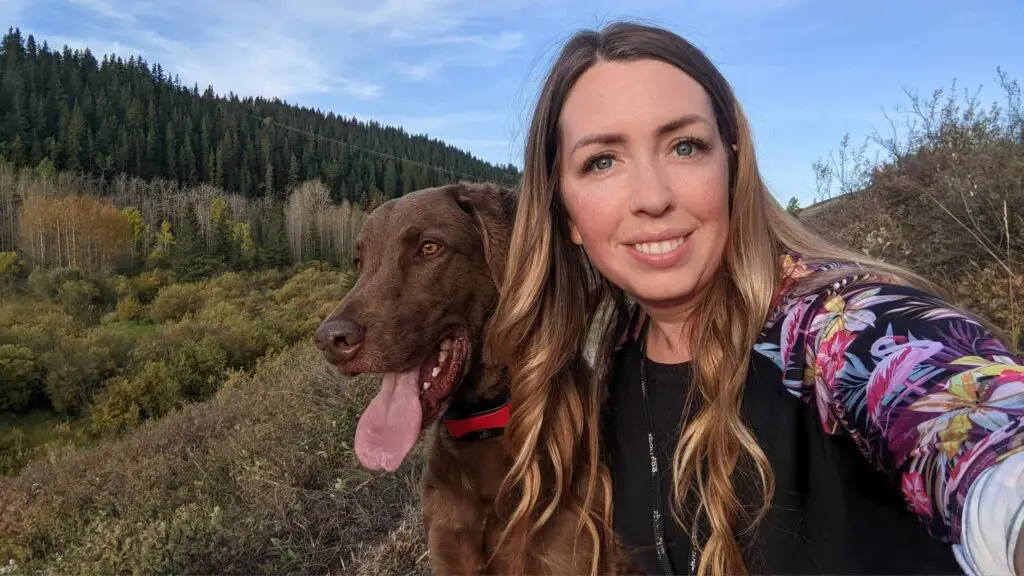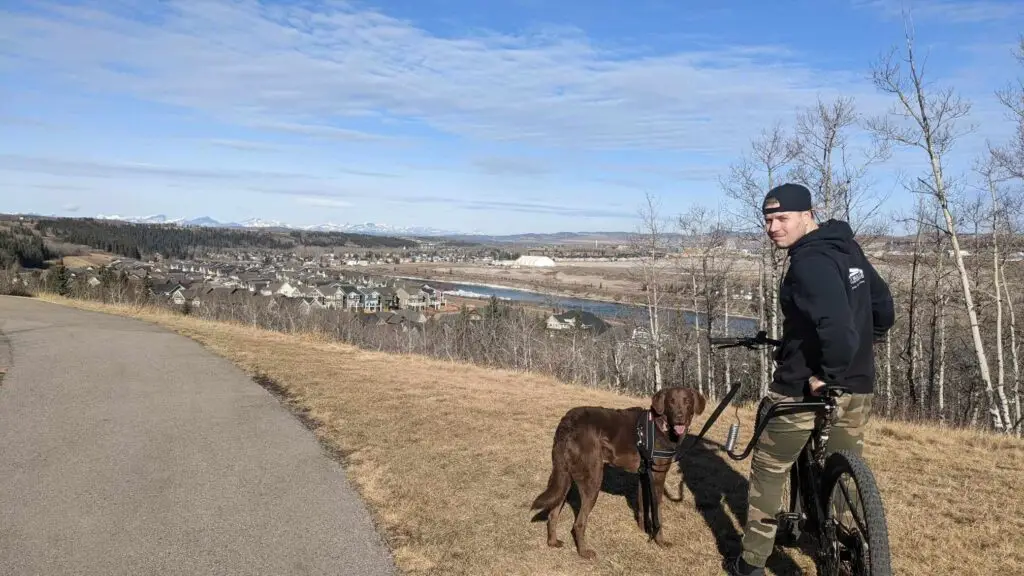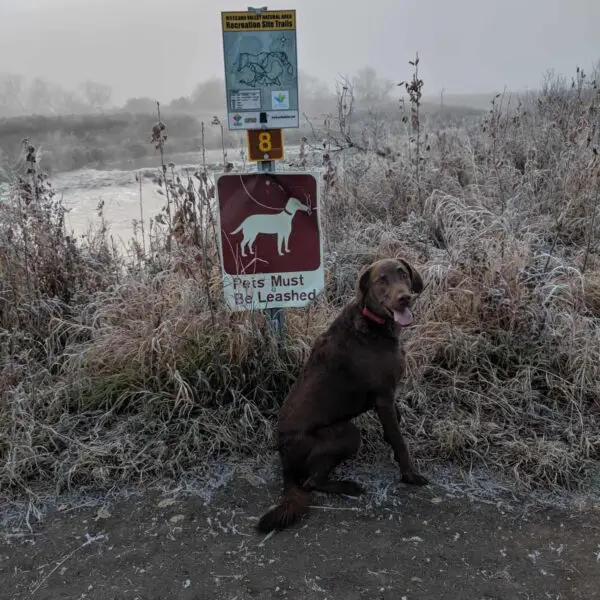Biking with your dog can be great exercise, mental stimulation and bonding for you and your dog. To ensure a smooth and enjoyable experience on the trails, it’s important to take a few preparatory steps to get your dog ready for the adventure. With the right preparation, you and your pup can enjoy the many benefits of biking together without any hiccups. In this article am going to tell you my top 5 tips for getting your dog bike trail ready so you both can enjoy off leash riding.

1. Assessing your dog’s temperament, physical ability and social skills for the bike trails
Not every dog makes a great trail dog – and even with the most rigorous training regiment – it’s important that you understand your dog’s limits. So before we dive into training doing a general and honest assessment of your dog is key. Reactive dogs, high prey drive dogs, and dogs that have physical impairments such as breathing issues due to their breed, hip issues, or general poor health won’t make for great trail companions.
Researching your dog’s breed & talking to your vet to determine your dog’s age & capability for long distance cardio is going to be key.
The next step is assessing their social ability. Are they a social dog who has met over 100 dogs? How did they react to those dogs? Are you comfortable with them at the dog park? Do they pick fights or pester other dogs? You want your dog to be perfectly comfortable passing other dogs, and ignoring them. Trails are not dog parks and having a fun-loving dog that wants to play with every dog is great at the dog park but can pose dangers on the trails. This should go without saying – but if your dog is reactive or picks fights with other dogs- for everyone’s safety- it doesn’t belong on the trails.
The same goes for dogs that want to chase wild life and can’t be brought to – prey drive in the trails can turn problematic & dangerous- fast.
You want a well balanced dog that is socialized to other dogs, animals and people that has the physical build and capabilities for long distance, off leash adventures.
2. Training Tips For Trail Dogs
There’s two reasons why training is going to be critical, the first one is that your dog needs to have basic training skills to keep both of you safe on the trails- but also that your dog needs to be conditioned for the cardio demands that come with running alongside your bike.
I’m a firm believer that a dog needs to be a 100% dog in order to be trusted doing more challenging activities, like biking. What I mean by that is, it needs to listen to you 100% of the time – without fail.
Your dog should have a 100% success rate on “come” “sit” “down-stay” and “quiet.” If your dog chooses when to listen, and not to listen, they aren’t trail ready.
Once your dog has basic commands down, 100% of the time- you need to get them trained to being comfortable running alongside the bike. I’ll talk about equipment in a second, but the way I got my dog used to my bike was by doing short rides in my neighborhood beside me on a leash. It can be awkward at first, and they may try to run in front of the tires, or under the bike – which means you’re going to have to start out with short rides – going as slow as possible. Gradually increase your speed and distance over time. Make sure to wear safety equipment – and keep an eye on their toes if you’re practicing on pavement. Running at fast speeds on pavement can quickly tear their pads. So I recommend pavement runs only as a training tool – and not for long distance runs.
Practicing in the dog park – now it’s time to unleash your dog and see how it does with you and your bike in an off leash park. It’s best to practice this in a multi-use dog park if possible. If you don’t have one of those- check your dog park rules and bring your bike right into the dog park and see if your dog can follow you without being distracted by other dogs off leash. Ride slow as other dogs might not be used to bikes and be sure to be courteous to other visitors by using a bell or calling out if you are behind them.
Once you and your dog are feeling comfortable, it’s time to set out to the trails. It’s a good idea to plan for a short, easy trail at first.
Getting your pup familiar with staying out of your and others’ way is key. You and your dog will likely find what works best for you – some people prefer their dogs behind them, some prefer them several feet in front, some prefer them beside and off the trail. You’ll also need a protocol for keeping your dog out of others way as they pass. Honestly though, if your dog is socialized to the bike and is well balanced at ignoring people and animals– you’ll find your groove without much effort. Bring some treats for positive reinforcement for endorsing good behavior and make sure to make it a fun experience for you and your dog.
3. Must Have Biking Equipment For Dogs
Let’s face it – your dog is going to be off leash in the forest and you’re going to want assurance that you can control and find your dog if things go awry. Despite controversy around e-collars – it is my number one tool for not only training a 100% dog but it also provides me the assurance that I can control my dog at all times. Plus having GPS built in gives me the reassurance that I can find him if he gets lost. On the trails being able to control and locate my dog can be the difference between life or death. So I use a e-collar with GPS, and other safety features like bread crumbs to keep us safe.
I grew up with e-collars as my dad was an avid outdoorsmen so I grew up learning the correct and responsible use of them. If you’re new to e-collars and not familiar with the proper use of them, I highly recommend investing in e-collar training from a reputable trainer, whether online or in-person. Using an e-collar incorrectly is irresponsible and can have adverse effects creating new problems for you and your dog.
I’ve been using the Sport Dog Tek GPS Training Collar reliably for over 8 years now. You can purchase it on amazon here.
The next piece of equipment you’re going to want is a hands free bike leash attachment – the piece of equipment I use can be found here. I use this only on pavement- in my neighborhood. I do not use this on trails. This is primarily for practicing and getting them conditioned to the bike in areas where leashes are required.

One less thing you need to worry about is having a full dog dish so your dog can get hydrated. The collapsible dish with the carabineer makes it light an accessible to get your dog a drink when you’re out on the trails.
I keep vet wrap on hand at all times. It helps with bandaging a sore paw or pre-wrapping paws for a long haul. Trails have rocks and other surprises and it’s good to keep this on you for first aid just in case.
4. Know Your Bike Trails & Respect The Rules
There’s two reasons you want to know the trails, the first is to ensure your dog is allowed off leash there- and to ensure your dog can safely be off leash there.
Attempting to trail ride with your dog leashed up is a recipe for disaster – so you want to ensure your dog is off leash ready and ensure the trail is off leash friendly. This goes without saying, but if the trail is not off leash friendly – do not bring your dog trail riding there. Other patrons of the trails will likely have on-leash dogs who are not ready to encounter your off leash dog.
Trail information can often be found on Trail Forks or All Trails along with visiting your local trail websites.
In addition to this, you want to make sure you pre-ride all of the trails before taking your dog. Green, double track, grassy or soft dirt trails are ideal. Jagged, steep, black diamond narrow trails are not recommended to start out as your dog could get hurt. Use your judgement as you get used to the trails together to determine what your dog is capable of.

5. Make biking fun and enjoyable for you and your dog
The more fun it is for your dog, the more likely they are going to do what you want. Make sure to give them lots of positive reinforcement, ensure the weather is ideal for outdoor exercise, manage your frustrations, keep your training sessions short (start with 15 minutes), and don’t be afraid to hire a trainer along the way.
Most importantly, make sure it’s fun! If you’re finding that you can’t get your dog to be the dog you want it to be – that’s okay. Not all dogs make great trail dogs and sometimes it’s no fault of your own. It’s best to accept that and keep everyone safe if your training isn’t going the way it should. It’s more important that you and your dog are safe and sometimes that just isn’t possible on the trails together.

Hi, this is a comment.
To get started with moderating, editing, and deleting comments, please visit the Comments screen in the dashboard.
Commenter avatars come from Gravatar.